Andrea Doria (7/7)
Diving the Doria
It's Definitely Not For Everyone
by Barb Lander
photos by Brad Sheard
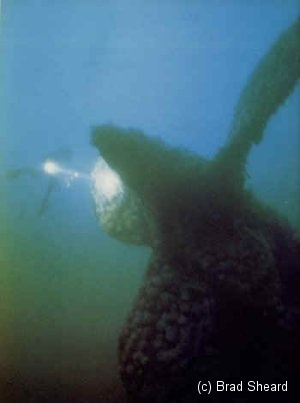
Beneath the predictably unpredictable Atlantic, the luxury liner Andrea Doria will mark its 40th year on the seafloor on July 26. Largely intact, the Andrea Doria is one of the premier wreck dives of the world. As mountaineers pit themselves against Denali or the Matterhorn, divers challenge the Atlantic to achieve a summit more than 200 feet below the waves. Most divers vehemently deny any desire to visit the Andrea Doria; a good thing since it is not a dive for "most" divers. After all, who would want to jump off a perfectly good boat 60 miles offshore, in 250 feet of water, in an area where 2 or 3 knots of current can develop in minutes and where 10 to 20 feet of visibility is often the norm?
Yet as many as 100 divers a year make one or more journeys to the Doria, three-quarters of them grizzled veterans, the rest nervous first-timers. If you are one of the breed that thrives on adventure and challenge, if you feel an almost mystical attraction to the " Grande Dame, " now is the time to start preparing. The equipment, planning, training, and experience necessary to dive the Andrea Doria can't be acquired overnight.
The HARDWARE

Plan to double up on large-capacity steel cylinders; 100s or 120s are ideal. The 160 cubic feet of gas available from double aluminum 80s is a marginal supply when the dive depth is between 180 and 230 feet ( where the goodies are. ) However, when choosing cylinders, keep in mind the dive is not over until you're safely back on the boat, and that means negotiating a ladder. Somehow the ladder seems to get higher and steeper, and the rungs farther apart, in foul sea conditions. Most divers choose to manifold their tanks together, allowing them access to the air in both tanks from one regulator. The second outlet is for a completely redundant regulator. High-pressure seat failure, freeze-up, and a severed hose are only a few of the dozen or more catastrophes that can beset you. Switching and still having access to all of your gas allows for an orderly retreat.

Diver John Yurga, geared up and heading down to the "Grande Dame".
Look for a Navy class-A rating or equivalent performance from your two main regulators. The density of air at depth and the sheer volume of gas to be moved at seven ATAs ( 200 feet ) makes breathing from sub-class-A regs feel like sucking a thick milkshake through a straw. Ease of hose configuration and resistance to freezing are other high-priority features to consider.
A drysuit is essential to protect yourself from the 40-degree bottom temperatures and the amount of time you'll spend submerged. Near the surface, the water may be as warm as 70 degrees, but don't count on it.
Jacket-style BCs are virtually unheard-of in the deep-dive community; back-mounted flotation has become de rigueur. The streamlined profile and 60 pounds and more of lift are highly desirable with double steel tanks. The integral harness system can be customized with D-rings and other carriers for equipment. Items you'll see incorporated onto a harness are varied: knives, backup lights, jon lines, retainers for regulators, argon bottles, primary lights, lift bags, tools, goodie bags, and strobes, to name a few.
Because there are no small mistakes at 200 feet, redundancy is the watchword. Carry two of every item of equipment vital to your health and well-being while underwater.
DECOMPRESSION
It is possible to dive the Doria without incurring decompression - but why bother? Most deep-diving novices choose to do a 15-minute bottom time to start; as experience and skill levels increase, bottom times move to 20 and 30 minutes with a total in-water time of 1. 5 to two hours. Dive computers are used, but only a few meet the criteria of the Doria diver. Computers that go out of range at 150 or 200 feet won't cut it, so look for a unit with a depth range of more than 250 feet. Second, the computer must calculate and tell you what your decompression is, not simply that you're in a decompression situation.
As for non-computer diving, there are always the dive tables. if you plan on diving the second-class china hole in 210 feet, however, the U.S. Navy standard tables won't work for you; they only go to 190 feet. A little more difficult to find are the Navy Extreme Exposure Tables, published in the U.S. Navy Diving Manual.
A third option is custom-generated tables. A half-dozen or more proprietary software programs are available that allow divers to create tables to meet their specific needs, but the programs are not idiot-proof. Garbage in, garbage out is the rule. This software will create tables for any depth, duration, and gases that you designate - without expressing an editorial opinion.
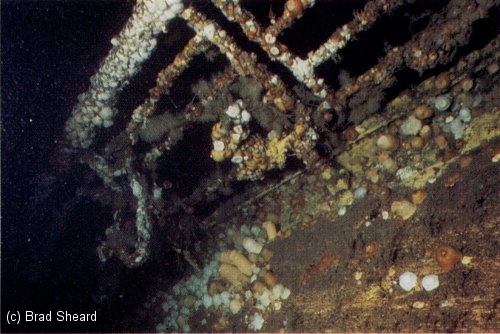
YOU CAN'T BUY THIS
Anyone with a credit card can buy the necessary equipment, but diving the Doria is far more than equipment. Physical and mental preparedness are essential. You are the one who has to be able to carry those doubles up a ladder in 4- to 6-foot seas, you have to be prepared to swim against and decompress in a ripping current, and you must be able to problem-solve underwater. Choosing not to dive except in "perfect" conditions is not enough. Conditions can change quickly - a dive that started perfectly can deteriorate to ug-lee in the 90 minutes you're in the water.
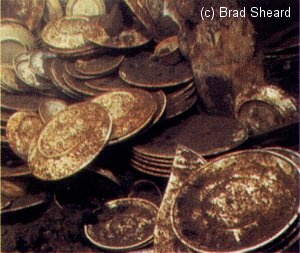
A mound of second-class china found inside one of the ship's stairwells.
On a recent Doria dive, I was happily decompressing, floating about 10 feet off the decompression line in calm, no-current conditions. In less than a minute the current picked up to a rate described by divers as screaming. Hanging out off the line, I was nearly swept away. Getting back to the line and completing my decompression was a brutal test of endurance, not to mention an entertaining show for the other divers on the line. On an earlier trip, a diver was swept away when he was swimming down the anchor line without holding on. At about 100 feet the current changed from zero to "uh-oh." When the diver failed to return after his dive, a search was instituted, and after several hours of searching the diver was located adrift, miles behind the boat.
Another vital part of your preparation includes knowing how to use all that equipment. A line reel and lift bag are worthless or even dangerous if you don't. Line reels and lift bags are used to send artifacts to the surface and/or to create an on-the-spot ascent line if the boat's ascent line is not available - i.e., you're lost. Tying off to the wreck means you will arrive at the surface within sight of the boat and be able to remain there if necessary.
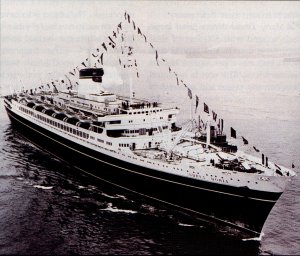
HISTORY
The Andrea Doria, named after one of ltaly's most beloved admirals, was the pride of the Italian Line. Launched in 1951, she was touted as a floating art gallery; paintings, sculptures, tapestries and ceramic friezes were located throughout the ship. Decorative appointments in the way of china, crystal, silver and hand-painted vases were lavish. July 25, 1956, the Doria, under the command of Capt. Piero Calamai, was feeling her way rough a thick fog toward New York. A short distance away the out-bound Stockholm steamed full speed ahead under a moonlit sky. A misinterpretation of radar data that has never been satisfactorily explain brought the two liners together in a fatal collision. Forty-six of the Andrea Doria's passengers died, more than 1,600 were rescued. Shortly after nine the next morning, bubbling furiously in protest, the Andrea Doria surrendered to the sea.
Many Doria divers favor large reels wound with 300 feet of sisal because it deteriorates rapidly and won't become a permanent hazard on the wreck. The reel is mounted between the tanks and secured in place with large rubber bands at the top and bottom. A leash fastened to the bottom of the reel and secured to a D-ring on the diver's harness allows for easy access. To deploy the line, grab the end of the leash and pull. Clip the lift bag to the end of the line, secure the artifact ( if you've got one, ) tie your reel off to a stationary object, inflate the bag and allow line to spin off the reel. Then cut the line, tie it off, stow the reel, and exit with panache.
Another item that requires practice is your manifold. Not only do you have to know how to use it, but you have to know which items are operated by which regulator. If the high-pressure hose for your gauges blows - which regulator do you shut off? Where are your inflator hoses? If you have to shut down one reg, it is always nice to have BC and suit inflation on different regs so you don't lose all your buoyancy control.
A favorite deep-diver exercise is to conjure up all the horrible things that could go wrong and decide ahead of time what are the proper responses. The object is to never be in a situation where your only option is prayer. Actual in-water rehearsals - other than on the Doria - are good ideas. Simulate regulator failure. Can you reach the valves? Quickly? More quickly than the tank can drain from a seat failure? Can you reach your line reel and lift bag? Can you deploy them quickly? Time yourself. If it takes five minutes to deploy an ascent line, what will it do to your deco? What will it do to your air supply? It takes a lot of gas to send a bag up from 200 feet, and this has to be taken into consideration. Five minutes is an eon at 200 feet. Practice shooting a bag until you can do it in less than two minutes.
FINDING YOUR WAY AROUND
Navigating the wreck can be a mental challenge too. The Doria lies on her side, so the floors and ceilings are the walls and the walls are the floor and ceiling. Confused? Try it under the influence of nitrogen. It is difficult to formulate a big picture in your head; the visibility limits you to seeing the wreck in 20-foot sections.
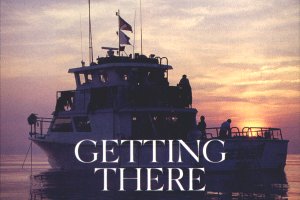
Now is the time to book your Doria charter if you are going this summer. Here is a run-down on the charter boats that make the trip.
Expect spartan accommodations on all the boats, some more so than others. Private cabins are nonexistent. Bring your own sleeping bag and pillow. Ear plugs will help ensure you get a good night's sleep. "Meals included" ranges from professionally prepared meals to hot dogs and potato chips.
The Doria is 50 miles from the closest point of land so expect to be at the mercy of the weather. July is the best month, but it is still possible to get blown out. Make sure you know what the blow-out, cancellation and refund policies are for your boat. At least one boat has a "no refund" policy.
You need to decide on the amenities that are important to you and choose a boat accordingly. Find out how many set of tanks you should bring; is air included? Oxygen? How long has the captain been going to the Doria? Have they ever had to cancel a trip? Why? What weather constitutes a blow-out? If the boat goes out no matter what, do you really to be out there no matter what? Ask lots of questions; caveat emptor. If at all possible, dive with the boat before you decide.
Don't just expect to sign up for a Doria trip. Expect to document your credentials. Be prepared to give references. The deep-diving community is a small one, so it is virtually impossible to get the background needed to tackle the Doria without meeting, training or diving with some of the heavyweights.
The diver mentioned earlier, who didn't hold on to the anchor line and was swept away, reported that he landed in the sand at 165 feet and swam around for a while looking for the wreck. Well, his story got a real laugh on the surface because the sand is at 250. The hull is at 165! There was such a vast expanse of featureless hull in all directions that, combined with a little nitrogen, he thought he was on the bottom.
The Andrea Doria is 700 feet long and had 11 decks. The upper two decks have now collapsed into the sand. Lifeboat davits draped with trawl netting protrude from the boat deck; a yawning cavern is all that remains of the funnel. The next deck is the promenade. The enclosed portion runs for several hundred feet in the midsection of the wreck; the windows that protected the promenade from the sea have collapsed downward so you can swim along the walkway where passengers used to stroll. Aft on the promenade deck you can swim in the third-class swimming pool. The forward end of the promenade terminates in an area known as the Winter Garden, from which two ceramic sculptures by artist Guido Gambone were recovered in 1993. It was a major salvage project; the panels weighed more than 800 pounds apiece. ( According to John Moyer, organizer of the project, the area that the massive panels were recovered from has since collapsed. The panels would have tumbled to the seafloor to certain destruction. )
Just below the forward end of the promenade is an opening known as "Gimble's Hole." It was cut into the wreck by a team led by Peter Gimble in 1981 as part of an attempt to recover two safes. Now divers use the opening to access the gift shop, first-class dining area, and kitchen. Studying deck plans can help you figure out where you are, and likely places to search for souvenirs. But keep in mind that many of the walls and partitions are gone. Landmarks that you may be counting on for navigation might not be there.
The descent line is usually tied in along the promenade deck close to either first, second or third class, depending on which spot is "hot" ( producing artifacts ) or what projects divers are working on. Plan to spend several dives learning the outside of the wreck before considering penetrating.
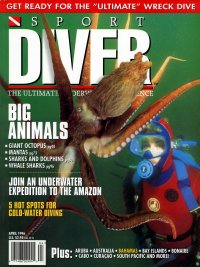
Veteran Doria divers have come to realize they are witnessing the end of an era. As the interior bulkheads yield to the sea and decks buckle and collapse, each visit marks an irretrievable moment in time. Too soon all that will be left of the Andrea Doria will be rubble ... and the stories, film images, and artifacts divers have accumulated.
Barb Lander is a wreck hunter and avid technical diver who has dived many of the East Coast's historic wreck sites. She has written several features for Sport Diver.
reprinted from Sport Diver magazine, March/April 1996
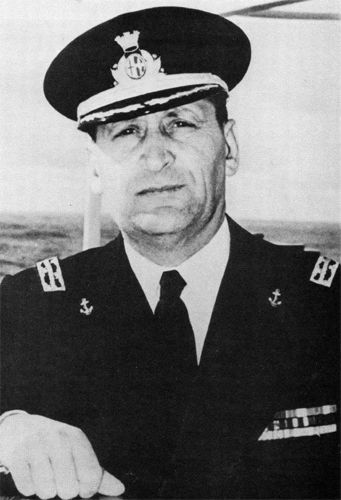
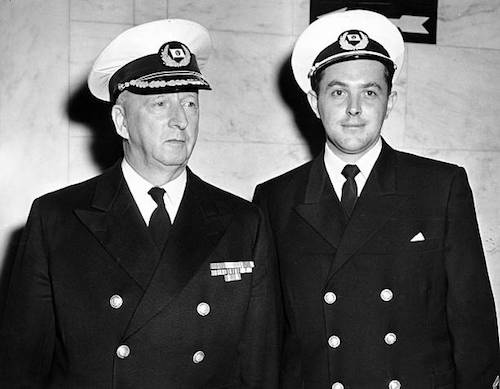

Italia Line ( or Italian Line ) was founded in 1932 by Benito Mussolini by merging several smaller shipping companies that were failing in the Depression. The line's first new ship was the famous liner Rex, which for several years held the Atlantic crossing record. The Italia Line proved to be a great success, but all of it's major vessels were destroyed in World War II.
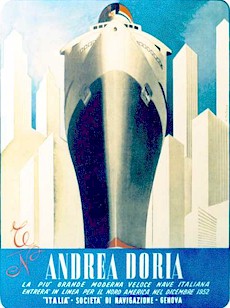
After the war, the line restarted with two ships, the Andrea Doria and her identical sister Christoforo Colombo. After the loss of the Andrea Doria, the Italia Line immediately ordered a replacement, which was delivered in 1960. The Leonardo da Vinci was essentially an enlargement of the same design, and closely resembled the Andrea Doria, although with many detail improvements. All three ships suffered from a flawed hull design which rendered them somewhat unstable in rolling, something that probably contributed to the capsizing of the Doria.
The line's final ships were the enormous Michelangelo and Raffaello, which were retired in the early 1980s, at which point ocean cruising had been largely replaced by air travel. Italia continues in operation today as a freight line, now a subsidiary of CP Ships ( Canadian Pacific. )
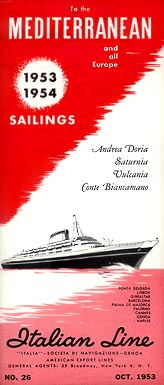
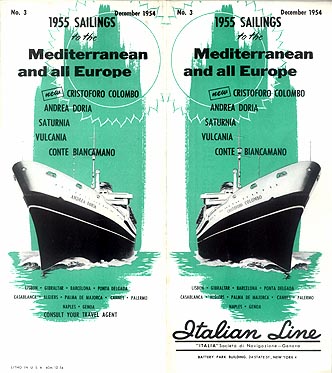
Admiral Andrea Doria - 1466-1560

Doria was born at Oneglia of the ancient Genoese family, the Doria di Oneglia branch of the old Doria, de Oria or de Auria family. His parents were related: Ceva Doria, co-lord of Oneglia, and Caracosa Doria, of the Doria di Dolceacqua branch. Orphaned at an early age, he became a soldier of fortune, serving first in the papal guard and then under various Italian princes. In 1503 he was fighting in Corsica in the service of Genoa, at that time under French vassalage, and he took part in the rising of Genoa against the French, whom he compelled to evacuate the city. From that time onwards, he became famous as a naval commander. For several years he scoured the Mediterranean in command of the Genoese fleet, waging war on the Turks and the Barbary pirates.
In the meanwhile Genoa had been recaptured by the French, and in 1522 by the Imperialists. But Doria now joined the French or popular faction and entered the service of King Francis I of France, who made him captain-general; in 1524 he relieved Marseille, which was besieged by the Imperialists, and helped to place his native city once more under French domination. Dissatisfied with his treatment at the hands of Francis, who was mean about payment, he resented the king's behaviour in connection with Savona, which he delayed handing back to the Genoese as he had promised. Consequently, on the expiration of Doria's contract he entered the service of Emperor Charles V (1528).
Doria ordered his nephew Filippino, who was then blockading Naples in alliance with a French army, to withdraw; Doria then sailed for Genoa where, with the help of some leading citizens, he expelled the French and re-established the republic under imperial protection. He reformed the constitution in an aristocratic sense, most of the nobility being Imperialists, and put an end to the factions which divided the city. He refused the lordship of Genoa and even the dogeship, but accepted the position of perpetual censor, and exercised predominant influence in the councils of the republic until his death. He was given two palaces, many privileges, and the title of Liberator et Pater Patriae (Liberator and Father of the Fatherland).
As imperial admiral he commanded several expeditions against the Turks, capturing Corona and Patras, and co-operating with the emperor himself in the capture of Tunis (1535). Charles found him an invaluable ally in the wars with Francis, and through him extended his domination over the whole of Italy. Doria's defeat by the Turks at Preveza in 1538 was said to be not involuntary, and designed to spite the Venetians whom he detested. He accompanied Charles on the ill-fated Algerian expedition of 1541, of which he disapproved, and by his ability just saved the whole force from complete disaster. For the next five years he continued to serve the emperor in various wars, in which he was generally successful and always active, although now over seventy years old; there was hardly an important event in Europe in which he had not some share.
After the Peace of Crepy between Francis and Charles in 1544, Doria hoped to end his days in quiet. However, his great wealth and power, as well as the arrogance of his nephew and heir Giannettino Doria, made him many enemies, and in 1547 the Fieschi conspiracy to upset the power of his house took place. Giannettino was murdered, but the conspirators were defeated, and Doria showed great vindictiveness in punishing them, seizing many of their fiefs for himself. He was implicated in the murder of Pier Luigi Farnese, duke of Parma and Piacenza, who had helped Fieschi.
Other conspiracies followed, of which the most important was that of Giulio Cybo (1548), but all failed. Although Doria was ambitious and harsh, he was a patriot and successfully opposed the emperor Charles's repeated attempts to have a citadel built in Genoa and garrisoned by Spaniards; neither blandishments nor threats could win him over to the scheme. Nor did age lessen his energy, for in 1550, aged 84, he again put to sea to punish the raids of his old enemies the Barbary pirates, but with no great success. War between France and the Empire having broken out once more, the French seized Corsica, then administered by the Genoese Bank of St George. Doria was again summoned, and he spent two years (1553-1555) in the island fighting the French with varying fortune.
He returned to Genoa for good in 1555, and being very old and infirm he gave over the command of the galleys to his great-nephew Giovanni Andrea Doria, the son of Giannettino Doria, who conducted an expedition against Tripoli, but proved even more unsuccessful than his uncle had been at Algiers, barely escaping with his life. Andrea Doria left his estates to Giovanni Andrea. The family of Doria-Pamphilii-Landi is descended from Giovanni Andrea Doria and bears his title of prince of Melfi. Judged by the standards of his day, Doria was an outstanding leader.
from Wikipedia
The name Andrea Doria has a long-running tradition in the Italian Navy:
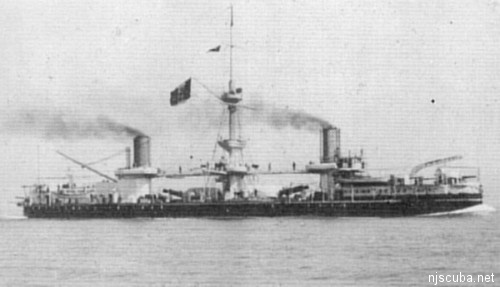
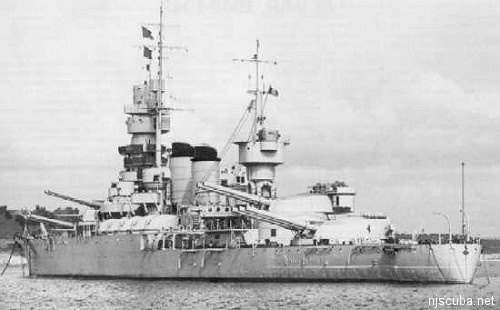
Launched 1913, extensively rebuilt 1937-1940. She survived World War II mainly by staying out of it - her 13" guns would have been no match for the British ships in the Mediterranean. Scrapped in 1957. This battleship was smaller than the liner Andrea Doria.
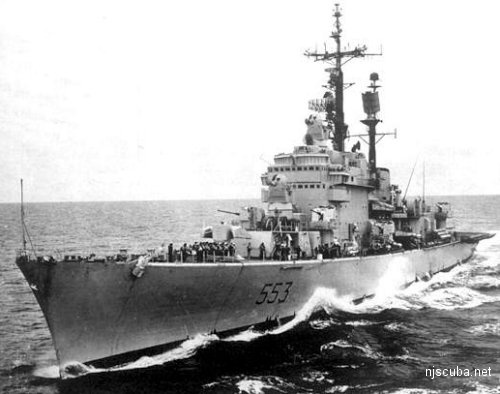
( also had a sister Caio Duilio )
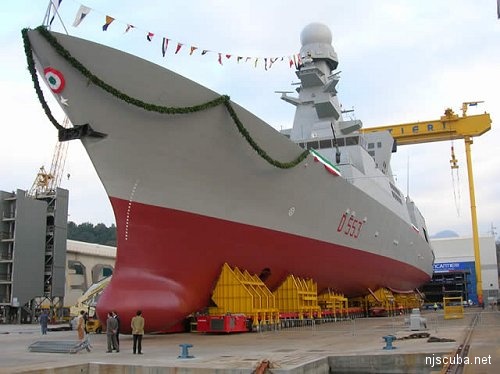
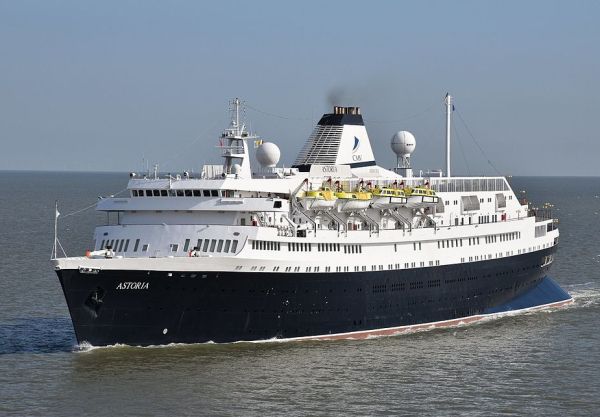
Incredibly, the Stockholm survives to this day. After extensive rebuilding and modernization, she sails as the cruise ship Astoria. At 72 years old in 2020, she is the oldest passenger liner still sailing in deep water routes.

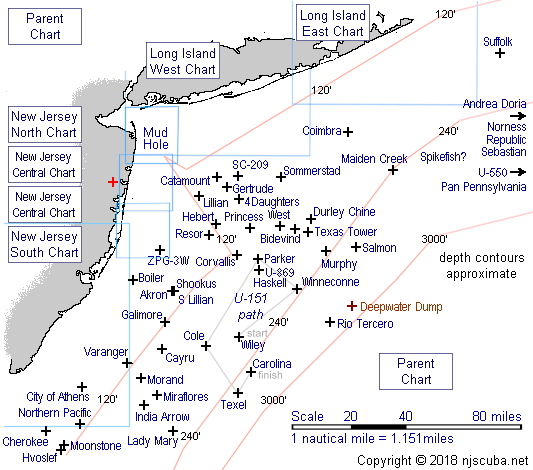
Questions or Inquiries?
Just want to say Hello? Sign the .